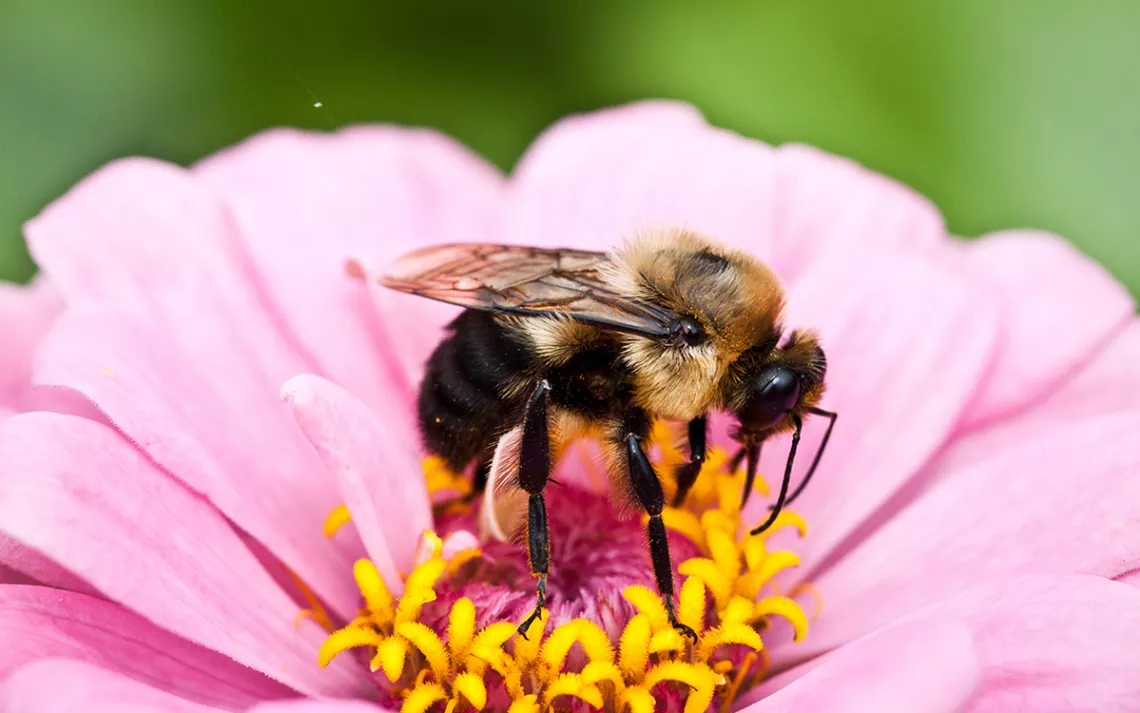The Mysterious Death of the Bumblebee Queens
Bumblebee colonies are being used by farms to pollinate—with unexpected consequences

Common eastern bumblebee (Bombus impatiens), Inniswoods Metro Garden, Westerville, Ohio. | Photo by Kelly Taylor/Alamy Stock Photo
When Olivia Miller peeked inside the bumblebee nest boxes, she expected to find a single queen amid a sea of workers. She did not expect to find a handful of dead bumblebee queens strewn across the nest.
At the time, Miller was studying applied ecology and environmental science at Cornell University. She was also part of a group of researchers investigating whether bringing in bumblebees raised in commercial facilities could boost pollination on farms that grew strawberries early in the season (in May, when the number of pollinators tends to be low) and then tomatoes later on (when pollinators are more abundant).
The team felt confident that adding commercial bumblebee colonies would lead to better pollination. Bumblebees are more effective at pollinating certain crops than honeybees, in part because of a behavior called buzz pollination, explains Heather Grab, a senior lecturer in Cornell’s School of Integrative Plant Science. “They latch on to a flower with their mandibles, and then they vibrate their flight muscles without actually moving their wings, and that releases pollen from the anthers of some really specialized kinds of flowers.”
Tomatoes are particularly well known to benefit from buzz pollination. But, to their surprise, the team found that tomato plants in fields with commercial bumblebee colonies actually received fewer visits from bees than plants in fields without. Not all bee species seemed to be affected, though. While visits from common eastern bumblebees (Bombus impatiens) dropped in number, those of other bee species did not. Common eastern bumblebees are frequently seen in the wild across eastern North America, and are also the same species that was used in the commercial colonies.
And then there was the mystery of the dead wild bumblebee queens, most of which were also common eastern bumblebees. “Very shortly after we placed commercial colonies in the field, we started observing these really large numbers of dead queens accumulating in them,” says Miller. “That was very unexpected and very concerning.”
These findings, which they recently reported in the Journal of Applied Ecology, pushed them to investigate further. “That really launched the project in this whole other, I think, probably more important direction,” says Grab. The team read up on bumblebee behavior and found a potential explanation: When bumblebee queens search for a nest site, they can either start their own colony or “usurp” an established colony by sneaking in and replacing the resident queen. This usurpation behavior usually happens in the spring, when bumblebee colonies are still getting established and have few workers defending the nest. So in the wild, usurpation attempts are often successful.
Since the commercial colonies had come fully stocked with workers, if wild queens tried to usurp, they were immediately overwhelmed by a massive number of worker bees. This unfortunate timing translated into fewer bumblebee colonies in the area. “Each one of those dead wild queens is a queen who potentially could have started her own colony and produced workers that would have pollinated later-blooming crops,” explains Miller. The commercial bumblebee colonies were actually reducing pollination of some crops by acting as deadly traps for wild bumblebee queens.
It’s a situation where timing is everything. In spring, when wild bumblebee queens are looking for nests, commercial colonies are also being put out to pollinate early-season crops. “The natural cycle of bumblebees means that at that time of the year, we just don’t have that many,” says Karen Goodell, an ecologist at the Ohio State University who was not involved in this study.
This usurpation-gone-wrong effect is far from the first case in which commercially raised pollinators have brought unanticipated consequences to an ecosystem. Sydney Cameron, an entomologist at the University of Illinois Urbana-Champaign who was not involved in this study, explains that disease transmission from commercial bees may have contributed to population declines among wild bumblebees. But, she adds, “I don’t think we’re going to get rid of commercial bees, because the farmers want them and because wild bees have declined due to loss of habitat.” Cameron says that large-scale agriculture has pushed wild bees out of their former habitats, making it harder for farmers to pollinate their crops. “They probably, in some cases, do need enhanced commercial bees,” she says, “but they don’t need to have that many and that density.”
Miller, Grab, and the other researchers began thinking about a queen excluder—a small plastic device that reduces the size of the opening so that bumblebee queens are not able to pass through, while smaller worker bees can. The excluders are designed to keep the resident queen inside the box, but the researchers figured that they should also be useful for keeping wild queens out.
The team set up eight large weather-resistant containers, each holding two commercial colonies—one with a queen excluder and one without—and distributed them among eight apple orchards. After two weeks, they retrieved the nest boxes from the containers and counted the number of dead queens inside. On average, they found 10 dead bumblebee queens in each nest box that lacked a queen-excluder device. Three wild queens also died in a box with a queen excluder, but only during a two-day period in which the device was set incorrectly. When used properly, the queen-excluder devices were 100 percent effective at preventing usurpation attempts, and therefore deaths, of wild bumblebee queens in the area.
The team also looked into whether there could be any downsides to adding queen excluders. They counted and measured bees in each colony and found no effects from the queen excluders on the number or size of worker bees or on the survival of the resident queen. The excluders seemed to eliminate the problem of accidentally trapping wild bumblebee queens, without causing any new problems for the commercial colonies.
Now the team is hoping the bumblebee industry will adopt widespread use of these devices to help protect wild bees and maximize crop pollination. “They’re a really simple, inexpensive solution that’s easy to implement. So I’m hopeful that they’re going to become standard,” says Miller. “Especially since we show that there’s no negative effects on the commercial colony,” she adds. “Growers only stand to benefit from using them.”
 The Magazine of The Sierra Club
The Magazine of The Sierra Club



